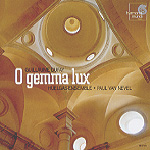Modern ears have been subjected to a sound world so complex and chaotic–and just plain noisy–that it’s impossible for us now to really appreciate the original contextual significance of works such as these 15th century motets of Guillaume Dufay. We can enjoy them on many levels and we can intellectually understand their importance, but when we hear these very complex rhythms, and harmonies that often have a strange, vacant quality, we can’t erase from our memory the fact that we’ve heard Brahms and Ives and Stravinsky. But I picked those three composers because each owes something to Dufay and to others who wrote in ancient forms and styles, in this case the isorhythmic motet. Much like Bach’s works were at the same time a summation and epitomization of the Baroque, so were these motets of Dufay in their way a final, ultimate statement regarding one of the more sophisticated musical forms of the Middle Ages. Simply put, the isorhythmic motet begins with a particular rhythmic formula or pattern that’s applied to a melody in one or more voices and repeated several times throughout the piece. The structure can get quite complicated, especially if different rhythmic formulas are used for different voices, making for irregular patterns of repetition. Dufay was a master of this compositional technique and as you listen you can see why later composers looking for interesting new ideas would have found very fertile ground among pieces like these. Conductor Paul Van Nevel organizes the program chronologically so the careful listener can follow the gradual stylistic changes Dufay employed from first motet to last–a range of approximately 20 years. His singers and instrumentalists, the always intriguing, musically polished, and stylistically informed Huelgas Ensemble, just seem to revel in the music–somehow reaching back to that motorless, unplugged time where no sound was amplified or transmitted except by means of natural acoustics, where voices and instruments were commonly heard resonating from stone and wood. And we get that too, thanks to Harmonia Mundi’s skillful miking in the suitably ancient, resonant space of l’Abbaye-aux-Dames.
































